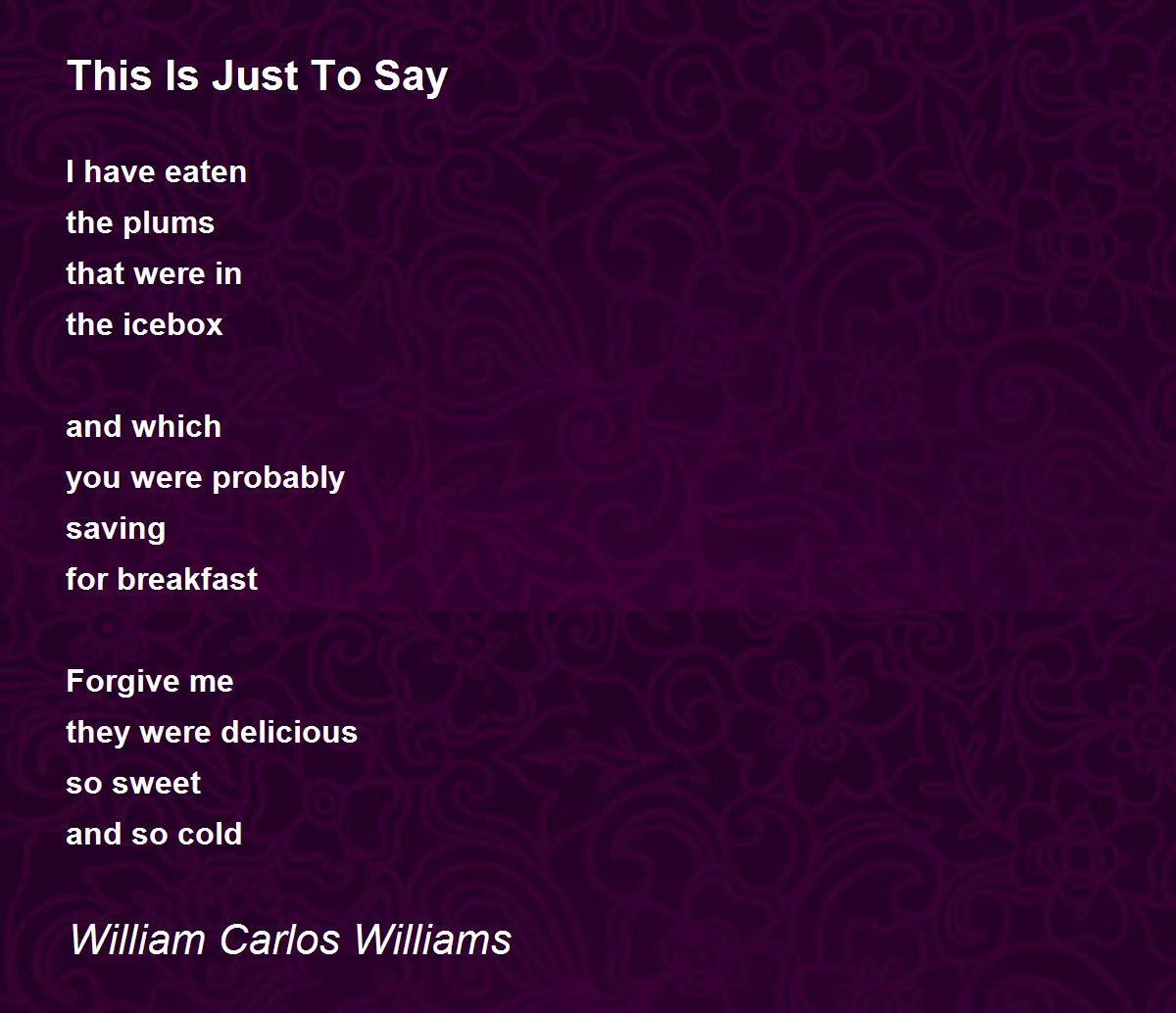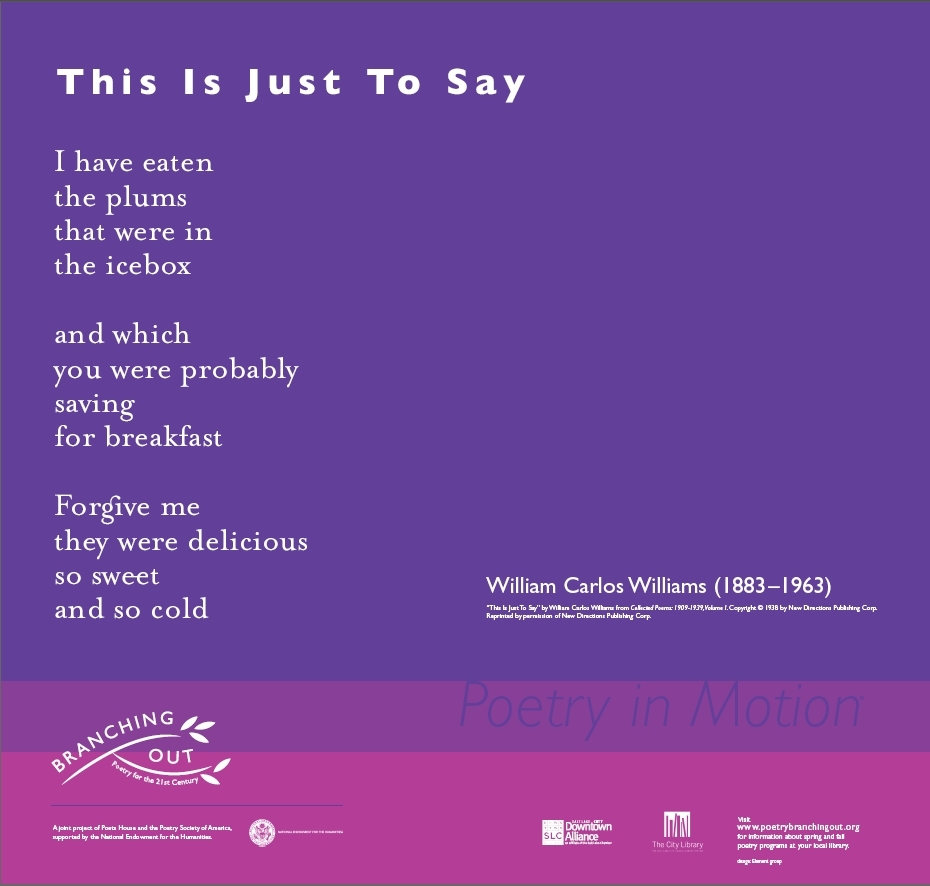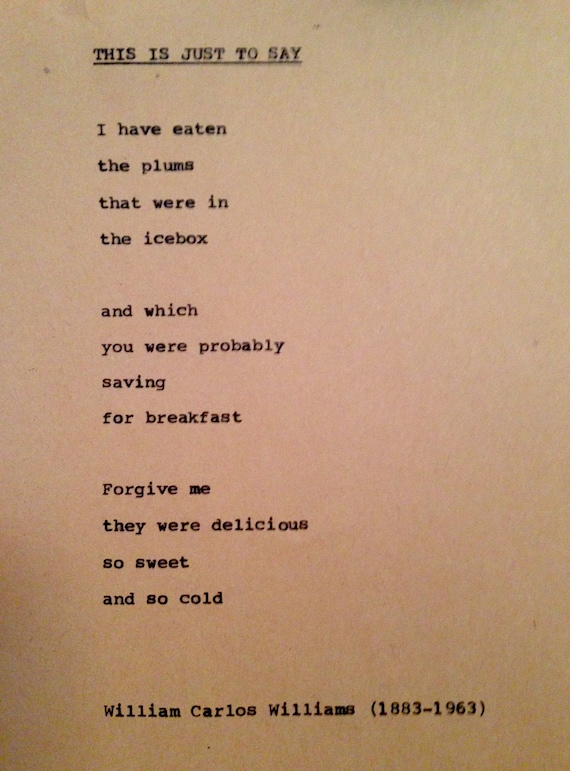
This Is Just to Say Poems on the Underground
Poet, novelist, essayist, and playwright William Carlos Williams is often said to have been one of the principal poets of the Imagist movement. About William Carlos Williams Occasion Breakfast Themes Eating Home * More by this poet The Red Wheelbarrow

William Carlos Williams & This Is Just to Say Susannah Fullerton
" This Is Just to Say " (1934) is an imagist poem [1] by William Carlos Williams. The three-versed, 28-word poem is an apology about eating the reader's plums. The poem was written as if it was a note left on a kitchen table. It has been widely parodied. [2] [3] Poem I have eaten the plums that were in the icebox and which you were probably saving

Poetry "This Is Just To Say"... By William Carlos Williams Sayings
Tone. "This Is Just to Say" is characterized by a gently satirical tone. This tone is admittedly easy to miss. Indeed, if we read the poem as nothing more than a speaker apologizing for having eaten the last plums, then we'll miss how Williams references the biblical story of the Fall. In the Bible, Adam and Eve commit the first sin by.

This Is Just To Say Poem by William Carlos Williams Poem Hunter
A Short Analysis of William Carlos Williams' 'This Is Just to Say' By Dr Oliver Tearle (Loughborough University) 'This Is Just to Say', a 1934 poem written by the American modernist poet William Carlos Williams (1883-1963), offers itself to the reader as a note left by the poet to his wife.

Shania This is just to say Poem
This Is Just To Say by William Carlos Williams - Famous poems, famous poets. - All Poetry This Is Just To Say I have eaten the plums that were in the icebox and which you were probably saving for breakfast Forgive me they were delicious so sweet and so cold © by owner. provided at no charge for educational purposes Like ( 487) 588 likes

This is Just to Say
To return to the religious symbolism suggested in the rest of the poem, this ending suggests the importance of living for the present moment rather than preserving oneself for rewards in the afterlife. Analyze the poem This is Just to Say by William Carlos Williams including famous quotes, symbolism, and other literary devices with SparkNotes.

Room 5 Pt England School This is just to say By Jordin
Williams was a leading figure in the Imagist movement, and many of his best-remembered poems, such as "The Red Wheelbarrow," are closely associated with it. Although Williams wrote "This Is Just to Say" in 1934, and hence long after Imagism's heyday, the poem bears all the telltale signs of an Imagist poem. The Great Depression

"This Is Just to Say" by William Carlos Williams, submitted by
Analysis of Poetic Devices Used in "This Is Just To Say". Poetic and literary devices are the same, but a few are used only in poetry. Here is the analysis of some of the poetic devices used in this poem. Free Verse: Free Verse is a type of poetry that does not contain patterns of rhyme or meter. This is a free-verse poem with no strict.

"This is Just to Say” by William Carlos Williams, 1934 Contemporary
William Carlos Williams's "This Is Just to Say" contains three stanzas, each composed of four short lines. No line exceeds three words. In the first stanza, the narrator-writer of a memorandum.

This Is Just To Say, for William Carlos Williams, by EricaLynn Gambino
"This Is Just To Say" (1934) is a famous imagist poem by William Carlos Williams. William Carlos Williams was an Imagist, that is he ascribed to the view that poetry should be simplified,.

This Is Just To Say Sayings, Poems, Instruction
"This Is Just to Say" is a work of intimate detail, just a few words laid out neatly that hold so much more. He helped establish a new American street-and-backyard voice in poetry, minimalist and sketchy, in contrast to poets like T. S. Eliot and Ezra Pound, who preferred the European and Asian traditions. William Carlos Williams

This Is Just To Say by William Carlos Williams Poems
After it was published in 1934, it became one of Williams's most popular poems. With only 28 words and no continuous rhyme scheme, no meter, and no punctuation, "This Is Just to Say" captures an innocent apology for eating "the plums that were in the icebox," and yet it could mean much more. While many believe that the poem was a note.

This is Just to Say by William Carlos Williams and Variations on a
That means we're working with free verse, dear Shmoopers. Yet the attention to line breaks and form is very deliberate in this poem. This isn't some free for all, scribbled on the back of a grocery list. It's a poem. And poems are often all about how they appear on the page. "This Is Just To Say" is divided into three four-line stanzas, and the.

Letters as Stories This is Just to Say
To paraphrase: "I took the plums because I wanted to experience the pleasure of eating them now rather than later." In this second reading, the icebox symbolizes deferred pleasure.

Items similar to VintageLooking Typed Poem "This Is Just To Say" by
'This is Just to Say' by William Carlos Williams is a three stanza poem that is separated into sets of four lines, or quatrains. The lines are limited to one or two words only, spoken by a first person narrator. As is common within Williams' writing, there is no punctuation.

Aaron McCollough on William Carlos Williams’s “This is Just to Say
"This Is Just to Say" is a short poem written by the American poet William Carlos Williams in 1934, and which features a speaker apologizing for eating some plums. Williams is perhaps best remembered for his involvement in the short-lived modernist poetry movement known as Imagism, which took place in the mid to late 1910s.